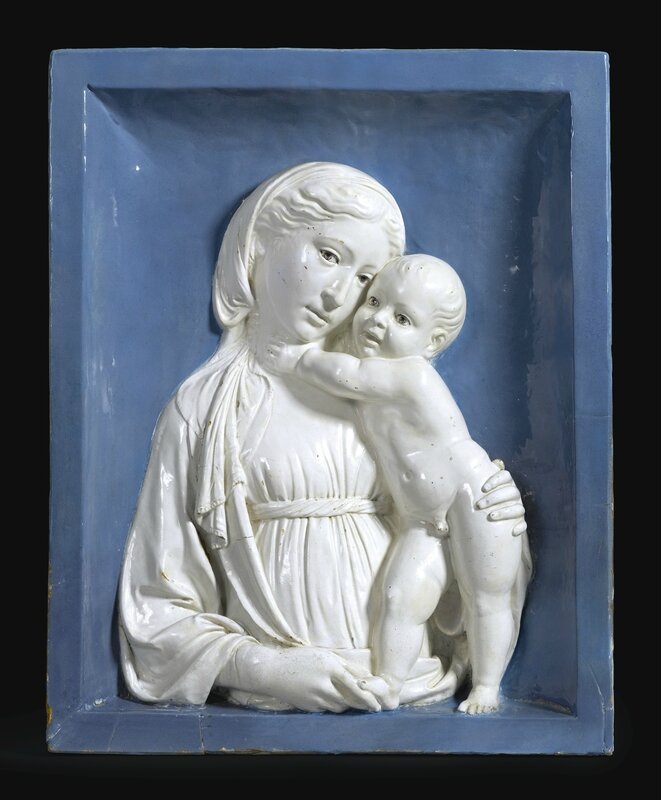Andrea della Robbia from a model Luca della Robbia, circa 1490-1500, Madonna and Child
Lot 12. Andrea della Robbia (Florence 1435-1525) from a model Luca della Robbia (Florence 1399/1400-1482), circa 1490-1500, Madonna and Child, tin-glazed earthenware, 20 5/8 by 16 1/2 in.; 52.5 by 42cm. Estimate 150,000 — 250,000 USD. Photo: Sotheby's.
Notes: Andrea della Robbia belonged to one of the most distinguished families of sculptors in the Renaissance. He worked alongside his renowned uncle, Luca della Robbia (1399/1400-1482), and later led their workshop with unparalleled success. While Andrea conceived of his own compositions, he also improved upon those of Luca. Luca’s relief of the Madonna and Child, invented in the 1460s, a type known as the ‘Bliss Madonna’ or ‘the Madonna of the Niche’, is only known in two examples, one in the Metropolitan Museum of Art, New York (67.55.98) and the other in the Museum of Fine Arts, Boston (30.1042). The present relief is the only known version of Andrea's late 15th century re-interpretation of his uncle's iconic composition. It illustrates Andrea's mastery of the medium of glazed terracotta and the tender relationship between a mother and child.
Here the Child leans adoringly into his Mother while steadying Himself by placing His tiny hands around the Madonna's neck. Their cheeks are almost touching; Her left hand grasps His supple skin and Her right hand gently clutches His foot, preventing Him from stepping outside of the framework. The Madonna gazes at the viewer knowingly while also creating a barrier with Her right arm; she is poised to protect her infant son from the outside world. This engaging composition depicts both vulnerability and reverence. The details of the edges of the Madonna’s drapery, it’s subtle folds, the locks of their hair, the attitude of the figures as well as the modest scale indicate that this relief was meant to be viewed from close proximity and therefore made for private devotion.
The dialogue between the arts in Florence is also illustrated here, master sculptors inspired painters and vice versa. As Cambareri notes (op.cit., p. 93), Fra Filippo Lippi’s (1406-1469) painting of the Madonna and Child, circa 1460, commissioned by the Medici (fig. 1) and now in the Palazzo Medici-Riccardi, resembles Luca’s sculpture in both design and spirit, representing the figures within a scalloped niche with a ledge in the foreground. Both the New York and Boston versions of this composition place the figures within a niche embellished with scalloped motifs and gilding. The spandrels provided space for the patron’s coats of arms.
Fig. 1. Fra Filippo Lippi (1406-1469), Madonna and Child, circa 1460, tempera on wood, Palazzo Medici-Riccardi
The present example was produced at a moment when ‘Robbiana’ became ever more advanced under Andrea’s leadership, and was often simpler in design in order to stimulate greater reverence in the viewer. The blue glaze represents the heavens and the luminous white exemplifies innocence and piety. Andrea was particularly influenced by the moral teachings of Savanorola; two of his sons, also important sculptors, became Dominican friars. His aesthetic was unadorned and didactic. The present sculpture is faithful to Andrea’s vision, it inspires contemplation while representing a quintessentially Renaissance image.
RELATED LITERATURE
A.P.Darr, Donatello e i suoi : scultura fiorentina del primo Rinascimento, exhibition catalogue, Milan, 1986, 79, p. 208
G. Gentilini, I Della Robbia. La scultura invetriata nel Rinascimento, Florence, 1992, pp. 60, 102, 163
I. Wardropper, European Sculpture, 1400-1900, in the Metropolitan Museum of Art, New Haven and London, 2011, pp. 20-22
M. Cambareri, Della Robbia. Sculpting with Color in Renaissance Florence, Boston, 2016
Sold with a copy of a thermoluminescence analysis report dated 29/09/2014 from Art-Test arte e Diagnostic stating that the sample taken, AO114, indicates that the date of the object is consistent with the presumed dating of the piece, 15th century.
Sotheby's. Master Paintings & Sculpture Evening Sale, New York, 25 Jan 2017, 06:00 PM

/https%3A%2F%2Fprofilepics.canalblog.com%2Fprofilepics%2F1%2F0%2F100183.jpg)
/https%3A%2F%2Fstorage.canalblog.com%2F03%2F02%2F119589%2F96711876_o.jpg)
/https%3A%2F%2Fstorage.canalblog.com%2F11%2F31%2F119589%2F94773502_o.jpg)
/https%3A%2F%2Fstorage.canalblog.com%2F20%2F83%2F119589%2F94772815_o.jpg)
/https%3A%2F%2Fstorage.canalblog.com%2F26%2F72%2F119589%2F75604929_o.jpg)
/https%3A%2F%2Fstorage.canalblog.com%2F59%2F60%2F119589%2F26458628_o.jpg)




/http%3A%2F%2Fstorage.canalblog.com%2F62%2F22%2F119589%2F122451290_o.jpg)
/http%3A%2F%2Fstorage.canalblog.com%2F20%2F28%2F119589%2F111407543_o.jpg)
/http%3A%2F%2Fstorage.canalblog.com%2F40%2F53%2F119589%2F110035333_o.jpg)
/http%3A%2F%2Fstorage.canalblog.com%2F24%2F72%2F119589%2F95281831_o.jpg)